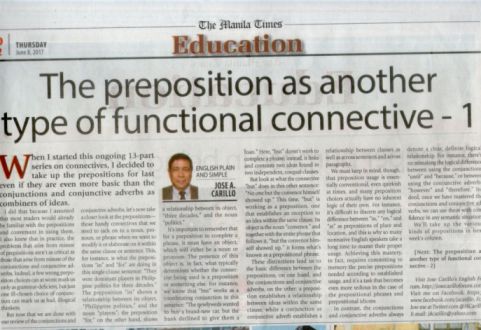When I started this ongoing 13-part series on connectives, I decided to take up the prepositions for last even if they are even more basic than the conjunctions and conjunctive adverbs as combiners of ideas. I did that because I assumed that most readers would already be familiar with the prepositions and adequately conversant in using them. I also knew that in practice, the problems that arise from misuse of prepositions aren’t as critical as those that arise from misuse of the conjunctions and conjunctive adverbs. Indeed, a few wrong preposition choices can at worst mark us only as grammar-deficient, but just one ill-chosen choice of conjunction can mark us as bad, illogical thinkers.
But now that we are done with our review of the conjunctions and conjunctive adverbs, let’s now take a closer look at the
prepositions—those handy connectives that we need to tack on to a noun, pronoun, or phrase when we want to modify it or elaborate on it within the same clause or sentence. This, for instance, is what the prepositions “in” and “for” are doing in this single-clause sentence: “They were dominant players
in Philippine politics
for three decades.” The preposition “in” shows a relationship between its object, “Philippine politics,” and the noun “players”; the preposition “for,” on the other hand, shows a relationship between its object, “three decades,” and the noun “politics.”
It’s important to remember that for a preposition to complete a phrase, it must have an
object, which will either be a noun or pronoun. The presence of this object is, in fact, what typically determines whether the connective being used is a preposition or something else. For instance, we know that “but” works as a coordinating conjunction in this sentence: “The newlyweds wanted to buy a brand-new car,
but the bank declined to give them a loan.” Here, “but” doesn’t work to complete a phrase; instead, it links and contrasts two ideas found in two independent, coequal clauses.
But look at what the connective “but” does in this other sentence: “No one
but the convenor himself showed up.” This time, “but” is working as a
preposition, one that establishes an exception to an idea within the same clause. Its object is the noun “convenor,” and together with the entire phrase that follows it, “but the convenor himself showed up,” it forms what’s known as a
prepositional phrase.
These distinctions lead us to the basic difference between the prepositions, on one hand, and the conjunctions and conjunctive adverbs, on the other:
a preposition establishes a relationship between ideas within the same clause, while
a conjunction or conjunctive adverb establishes a relationship between clauses as well as across sentences and across paragraphs.
We must keep in mind, though, that preposition usage is essentially conventional, even quirkish at times, and many preposition choices actually have no inherent logic of their own. For instance, it’s difficult to discern any logical difference between “in,” “on,” and “at” as prepositions of place and location, and this is why so many nonnative English speakers take a long time to master their proper usage. Achieving this mastery, in fact, requires committing to memory the precise prepositions needed according to established usage, and it’s a task that becomes even more tedious in the case of the prepositional phrases and prepositional idioms.

In contrast, the conjunctions and conjunctive adverbs always denote a clear, definite logical relationship. For instance, there’s no mistaking the logical difference between using the conjunctions “until” and “because,” or between using the conjunctive adverbs “however” and “therefore.” Indeed, once we have mastered the conjunctions and conjunctive adverbs, we can use them with confidence in any semantic situation.
We’ll take up the various kinds of prepositions in next week’s column.
(Next:
The preposition as another type of functional connective - 2) June 15, 2017
This essay, 1043rd of a series, appeared in the weekly column “English Plain and Simple” by Jose A. Carillo in the Education Section of The Manila Times
, June 8, 2017 issue (print edition only), © 2017 by the Manila Times Publishing Corp. All rights reserved.